The First Wave: Exploring early coastal contact history in Australia
For most Australians, the possibility of armed invasion is feared but unknown. Few people living on this land have experienced the disruption of armed conquest. How many of us could even begin to imagine what might have passed through the minds of Indigenous people when they first encountered non-Indigenous people on the coastal fringes of this continent?
READ REVIEW
↓
the first wave: Exploring early coastal contact history
edited by Gillian Dooley & Danielle Clode | 2019
The First Wave explores the dynamics of these early encounters in Australia’s colonial history, from fresh angles such as the Indigenous cosmological perspective, as well as more familiar ones like the European history of ideas. It strives to illuminate ‘the other side of the story’, an invasion by ‘others’ wearing alien costumes, bearing strange tools and ruthlessly enforcing the laws and customs of other places. In doing so, it helps us to think about how we begin to memorialise this monumental process proclaimed by the invaders as the ‘discovery of Australia’.
I believe, as do others, that Australians need to consider and understand colonisation for the sake of our national sanity, and art may help with this process. This collection, a valuable contribution to any discussion of colonial settler history, is different from ‘traditional history’ in many ways. Original research chapters (aka ‘Western scholarship’), interspersed with ‘creative responses’ ― poems by Yankunytjatjara writer Ali Cobby Eckermann, and by Molly Murn ― demonstrate the vital importance of local and applied knowledge. Skye Krichauff, Aaron Corn, Mark Dunn and others have contributed first-class investigations informed by their detailed and balanced work in the archives and with communities. All their work is respectful and worthwhile.
Although the entire book is eminently readable, two chapters stood out for this researcher ― Peter Sutton’s ‘Unofficial explorers: From Aurukun to Kendall River in 1927’ and Chester Schultz’s ‘Exile: Kalungku, “Emma”, and the sealers of the southern coast’. The first, based on original diaries, maps, photographs, and oral history, is important because Aboriginal and European women constituted the majority of the ‘exploring party’ and recorded their journey. Sutton’s lengthy and extensive fieldwork on the western shores of Cape York Peninsula mean that he is able accurately to identify and describe the individuals and the places mentioned in their archival records and historical accounts. This is not ‘armchair history’.
The second stand-out chapter, a gut-wrenching biography of an Aboriginal woman serially kidnapped by sealers and missionaries in South Australia, Tasmania and Victoria, is one of the few insights we can get into the experiences of Indigenous women on the maritime frontier. Kalungku’s life is doubly important because in 1838 she provided missionary Charles Robinson with a wordlist in Kaurna, the language of the Adelaide Plains. As Schultz observes, Kalungku ‘states her geographical self-identity with a clarity that is rare in nineteenth-century records’, thereby graphically and emphatically reminding us how crucial connection to place is for First Nations people’s identities. In my opinion, this particular chapter deserves to be widely shared and used as an educational resource.
The writers and editors are to be congratulated for having made significant contributions to, as Danielle Clode states, ‘ongoing critical discussion and investigation, and unsettling some of the current pre-settlement narratives’. I recommend this book to all those interested in understanding the beginnings of Australian history on the maritime edges of the continent, where adventurers and nomads from Europe and other places first began their annexation of Aboriginal land.
The First Wave is published by Wakefield Press.
Reviewer: Jonathan Richards, PHA (Qld)

